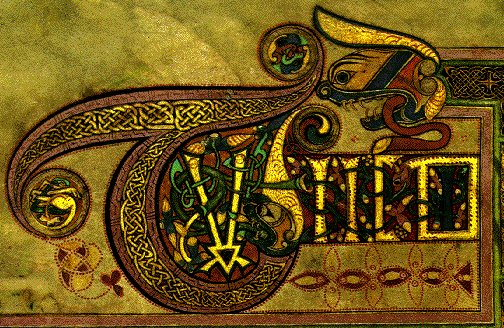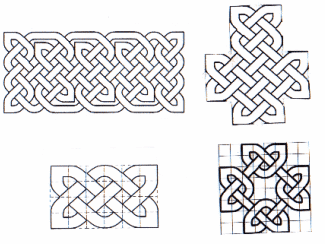Skip over navigation
Article by NRICH team
About 1200 years ago Irish Monks worked for years to create a masterpiece in 'illuminated' script, called the Book of Kells . This ancient book is now kept in Trinity College Library in Dublin.

Look closely at this piece of one page (above) and you will see a Celtic Knot design inside the huge fancy letter. This type of design has been studied by many people. Some people like Celtic Knots for artistic reasons, others are fascinated by the mathematics of the designs.
Many Celtic knots are continuous - as if they are made from one long piece of string. So they are 'mathematical' knots. Others are made up of sections, with each section made so that if you trace along the line you come back to where you started. So these are 'links' of mathematical knots.
Are these examples 'continuous' or 'linked' knots?

We also have a good article on our website called Links and Knots .



Or search by topic
Number and algebra
Geometry and measure
Probability and statistics
Working mathematically
Advanced mathematics
For younger learners
Age 7 to 11
Published 2011 Revised 2016
The Art of Celtic Knots
About 1200 years ago Irish Monks worked for years to create a masterpiece in 'illuminated' script, called the Book of Kells . This ancient book is now kept in Trinity College Library in Dublin.

Look closely at this piece of one page (above) and you will see a Celtic Knot design inside the huge fancy letter. This type of design has been studied by many people. Some people like Celtic Knots for artistic reasons, others are fascinated by the mathematics of the designs.
Many Celtic knots are continuous - as if they are made from one long piece of string. So they are 'mathematical' knots. Others are made up of sections, with each section made so that if you trace along the line you come back to where you started. So these are 'links' of mathematical knots.
Are these examples 'continuous' or 'linked' knots?

We also have a good article on our website called Links and Knots .
You may also like
A-maze-ing
Did you know that ancient traditional mazes often tell a story? Remembering the story helps you to draw the maze.
The Konigsberg Bridge Problem
This article for pupils describes the famous Konigsberg Bridge problem.
More on Mazes
There is a long tradition of creating mazes throughout history and across the world. This article gives details of mazes you can visit and those that you can tackle on paper.

